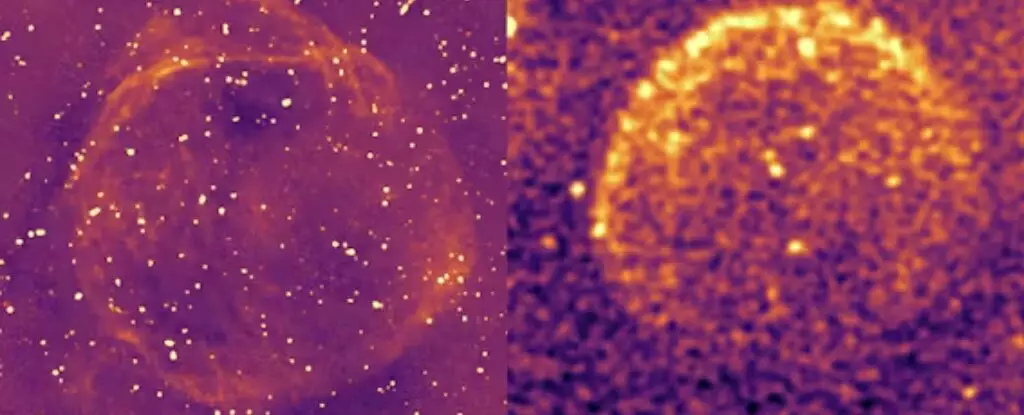Radio astronomy represents a crucial frontier in our quest to understand the universe. Unlike optical telescopes that depend on visible light, radio telescopes are designed to detect the faint whispers of the cosmos, revealing celestial phenomena that are otherwise hidden. With the advent of groundbreaking instruments like the Australian Square Kilometre Array Pathfinder (ASKAP) and MeerKAT, scientists are beginning to see a “low surface brightness universe” — a realm filled with enigmatic, faint radio signals.
This growing interest and capability in radio astronomy has resulted in significant discoveries, allowing us to probe deeper into cosmic secrets and to reconsider the nature of celestial objects that exist beyond our visual reach. This article will explore the profound implications of these discoveries and how they are reshaping our understanding of different astronomical phenomena.
Shedding Light on Low Surface Brightness Objects
Surface brightness serves as a pivotal metric in astronomy, providing insight into the visibility of cosmic objects. As radio telescopes become increasingly sensitive, the community is being introduced to new classes of radio sources. These faint emissions are revealing a universe teeming with hidden wonders – far more intricate than our existing knowledge suggested. The Extreme Low Surface Brightness findings from the EMU (Evolutionary Map of the Universe) program not only document our cosmic surroundings but also raise critical questions about star formation, supernovae physics, and even the galactic environment.
The emerging low surface brightness universe is characterized by objects that exhibit subtle features, where energy is dispersed unevenly. These newly revealed entities present unique attributes that challenge previous models of cosmic evolution, emphasizing the need for a shift in our astronomical paradigms.
Revisiting the Life Cycle of Stars
Among the fascinating revelations of ASKAP and MeerKAT are the elusive Wolf-Rayet stars, which form during the aging process of massive stars. The transformation of a regular star into a Wolf-Rayet involves significant loss of mass as they pulsate and shed layers. The ghostly manifestations of these stars often appear as delicate circular structures, helping astronomers visualize the complex dance of stellar life forces. The discovery of unique objects like Kýklos, exhibiting these ghostly circles, exemplifies how advanced radio astronomy can illuminate phases of stellar evolution that are not observable with standard optical telescopes.
Moreover, supernova remnants such as Stingray 1 and Diprotodon provide critical insights into the energetic explosions marking a star’s death. The circular formations produced by their shockwaves depict violent cosmic events, revealing structures shaped by the star’s final moments. Each discovery adds a stroke to the canvas of our understanding, allowing astronomers to reconfigure the narratives around stellar birth and death.
New Perspectives on Neighbors and Beyond
In addition to stellar phenomena, ASKAP has enabled an analysis of objects beyond the Milky Way galaxy. The advent of “radio ring” galaxies, which display stark contrasts between their optical and radio signatures, exemplifies how our perception of the universe can shift dramatically depending on the wavelength studied. The implications of this new understanding are profound, potentially hinting at mechanisms such as galactic collisions or the aftermath of supernova interactions.
The identification of strange entities like Odd Radio Circles (ORCs) underscores the limitations of existing models. These mysterious formations, visible solely in radio wavelengths, challenge astronomers to reconsider the origins of such spectral phenomena. They evoke a sense of intrigue and wonder—reminding us that the universe has yet to reveal many of its secrets.
Charting the Cosmic Landscape for Future Generations
The ongoing EMU survey is only a fraction of the astronomical treasure trove that awaits discovery. As its results continue to emerge, we will unearth more innovative structures and complex relationships within and beyond our galaxy. As astronomers employ cutting-edge analysis techniques, they will be able to glean insights into the daunting expanse of materials that constitute our universe.
The developments brought forth by MeerKAT and ASKAP stand as precursors to the ambitious Square Kilometre Array (SKA), a monumental endeavor set to enhance our capabilities even further. In this sense, we are at the cusp of a new era in astronomy, where the lines between the known and the unknown blend seamlessly.
The promise of technological advancements and collaborative efforts in radio astronomy signifies an exciting trajectory for cosmic discovery. The mysteries embedded within the low surface brightness universe compel us to remain curious and to continue our pursuit of understanding—ultimately revealing the beauty and complexity of the cosmos that lies beyond what the human eye can perceive.

